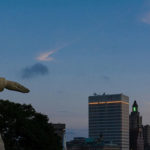Easter changes everything.
 Bill WilsonLike no other part of the Christian faith, the story of Easter is at the heart of what makes our faith unique and life-changing.
Bill WilsonLike no other part of the Christian faith, the story of Easter is at the heart of what makes our faith unique and life-changing.
Death is overcome by life.
Not even the grave is immune to the life-giving power of Jesus Christ.
Those simple statements have profound implications.
Across the centuries, this triumph of life over death has proven to be the spark that has inspired individual believers and the church. No obstacle has been too large, no challenge too intimidating. Men and women have found hope in the midst of oppression, loss and excruciating pain. Faith communities have leaned into challenges that seemed overwhelming with conviction, grit and confidence in victory.
Living on the right side of Easter makes all the difference in the world. There really are two sides of Easter, aren’t there?
One is the side of Easter the disciples experienced during the dark hours following the crucifixion. It is the side marked by discouragement, loss and despair. There is also the side of Easter those same men and women experienced when they discovered the tomb was empty and Jesus had been resurrected. This is life marked by confidence and hope.
Why, then, do so many of us, and so many of our churches, seemingly live on the wrong side of Easter? Think about the difference in a church that finds itself mired in a “pre-Easter” mindset versus a church that lives out of its “post-Easter” mindset.
Here are four key contrasts between the two:
Sign up for our weekly edition and get all our headlines in your inbox on Thursdays
A pre-Easter church believes only in what they can see. Thus, they work very hard and are convinced the kingdom will only come if they sacrifice and struggle and personally do the work to bring it to fruition. Life in the church is about effort, and much guilt is employed to motivate and drive the tasks that must be done. Life is marked by duty and obligation, along with resentment and frustration.
A post-Easter church believes in what they cannot see. They know the Spirit, not them, is responsible for supplying the power of the church. They live in alignment with the movements of God’s hand and are swept up in that sense of being part of something much larger than them. They are marked by joy and humility at being part of God’s unfolding drama.
A pre-Easter church relies upon human ideas and possibilities. These churches try program after program, hoping one will succeed where others have failed. There is much hand-wringing and scapegoating of staff and leadership as ideas are tried and fall short. They eventually become adept at saying “no” to any new idea, or greeting innovation with either “We’ve never done that before” or “We tried that and it didn’t work.”
A post-Easter church relies upon their “sanctified imaginations.” They are inspired by the Spirit to dream and explore possibilities others find ludicrous. These are the churches that surrounding communities notice and admire for their ability to innovate and create. They develop a permission-giving culture that greets new ideas with enthusiasm rather than disdain.
A pre-Easter church is fixated on the past. The glory days are always in the rear-view mirror, and there are many who long for a return to yesterday. Fond memories devolve into toxic nostalgia, and bitterness about cultural and congregational changes seeps into nearly every conversation. A prevailing sense that the best already has been permeates the life of the congregation.
A post-Easter church is focused upon the future. This crowd believes the best is yet to come. This church appreciates and honors the past but is convinced God is out ahead, calling his people into a dynamic and invigorating future. The witness and stories from their heritage inspire this church to risk boldly and live with confidence as they face the future.
A pre-Easter church lives in fear and dread. It is no wonder so many churches emulate the terrified disciples of Saturday before Easter Sunday. The headwinds of culture are strong, and the metrics of most established churches show decline. There is much to cause alarm, and these churches give in to the temptation to huddle up, raise barriers to those who are different, grow increasingly angry and become increasingly irrelevant.
A post-Easter church lives in confident anticipation. While not unaware of challenges, these churches believe God is at work and wants them to be engaged in the larger life of their city/community. They know politics, materialism and financial success all are false gods that will be shown to be unworthy of worship or devotion. Instead, they know the Good News of Jesus Christ is exactly what the world needs now. They believe there has never been a better day to be God’s people on a mission into the world.
Perhaps this Easter season is an appropriate time for us to remember: We are Easter People—365 days a year!
Bill Wilson is director of the Center for Healthy Churches.














We seek to connect God’s story and God’s people around the world. To learn more about God’s story, click here.
Send comments and feedback to Eric Black, our editor. For comments to be published, please specify “letter to the editor.” Maximum length for publication is 300 words.